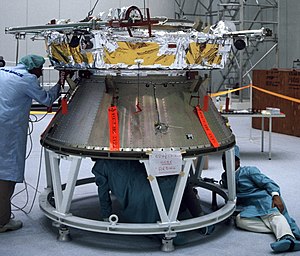Viking (satellite)
| Viking | |
|---|---|

|
|
| Country: |
|
| COSPAR-ID : | 1986-019B |
| Mission dates | |
| Dimensions: | 538 kg |
| Size: | 190 cm diameter, 50 cm height |
| Begin: | February 22, 1986, 1:44 UTC |
| Starting place: | Center Spatial Guyanais |
| Launcher: | Ariane 1 V16 |
| Status: | in orbit |
| Orbit data | |
| Rotation time : | 261 min |
| Orbit inclination : | 98.7 ° |
| Apogee height : | 13530 km |
| Perigee height : | 814 km |
Viking is a Swedish geophysical satellite . It is also Sweden's first satellite. It was brought into space by Kourou as a piggyback payload during the launch of an Ariane 1 rocket together with the French SPOT-1 satellite on February 22, 1986 at 1:44:35 a.m. UTC .
He was supposed to research the interactions between the solar wind and the electromagnetic field of the earth . For this it was brought on a very eccentric orbit with about 814 km perigee and about 13,530 km apogee , so that with an orbital time of 261 min more than 215 min at an altitude of more than 4000 km. The inclination of the orbit is 98.70 °. The satellite with the shape of an octagonal flat disc (190 cm diameter, 50 cm high) was spin stabilized and its solar cells with a total area of 2.2 m² provided an output of 85 watts (they were supported by NiCd batteries with 12 Ah capacity).
Viking had a launch mass of around 530 kg and a dry mass of 286 kg, with only 40 kg of the scientific equipment. This consisted of a UV light meter for polar light examinations , plasma wave detectors in the high and low frequency range, a vector electrometer , plasma spectrometer and magnetometer . The individual experiments were contributed by different groups of scientists from different countries (Sweden, Canada, Denmark, France, Norway, USA and Germany). In order to measure the electric fields in all three spatial directions, he unfolded two 4 m long rods in orbit in the axial direction and unrolled four ropes, each 40 m long, each with a sensor system at the end.
By May 12, 1987 (more than 200 days longer than planned) it delivered very valuable data (via S-Band ) to the ground station in Esrange (Sweden).
Web links
- Viking at the Swedish Space Corporation ( Memento from October 11, 2004 in the Internet Archive )
- Information about Viking on Gunter's Space Page (English)
- Vikin (Sweden) in the Encyclopedia Astronautica (English)